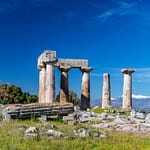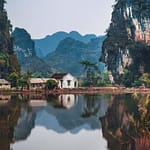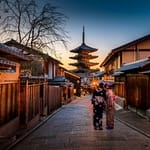- Aisa
- Cebu
- Philippines
Unveiling the Wonders and Thrills of Cebu on a Journey Through the Heart of the Philippines.
Nestled in the central region of the Philippine archipelago, Cebu is a vibrant blend of rich history, natural beauty, and thrilling adventures. Known as the “Queen City of the South,” Cebu invites travelers to experience its stunning white-sand beaches, world-class diving spots, majestic waterfalls, and centuries-old heritage sites. Whether you’re exploring the bustling urban life of Cebu City or discovering the untouched beauty of its surrounding islands, this destination offers something for every kind of traveler. Join us as we journey through the heart of Cebu, where every corner reveals a new wonder and every moment sparks adventure.
- Unveiling the Wonders and Thrills of Cebu on a Journey Through the Heart of the Philippines.
- Crafting the Ultimate Cebu Travel Experience
- Best Time to Explore Cebu Island
- Must-Know Travel Tips for Cebu Visitors
- Getting to Cebu and Exploring Locally
- Best Things to Do in Shibuya
- Exploring the Stunning Beauty of Kawasan Falls
- Exploring the Historic Legacy of Magellan’s Cross
- Experience World-Class Diving in Moalboal Waters
- A Majestic Experience with Oslob Whale Sharks
- Embark on a Malapascua Island-Hopping Journey
- Hike to Breathtaking Osmeña Peak Views
- Discover Tranquility on Bantayan’s Beautiful Beaches
- Bouldering Adventure Awaits at Miyashita Park
- Delight in Traditional Cebuano Food and Seafood
- Explore Cebu’s Untouched Falls and Landscapes
Crafting the Ultimate Cebu Travel Experience
If you’re drawn to the thrill of island-hopping and the laid-back magic of tropical escapes, Cebu Island in the Philippines is your next dream destination. This sun-kissed paradise is not only celebrated for its crystal-clear waters and white-sand beaches but also for its deep-rooted cultural heritage and wealth of natural wonders. Nestled in the heart of Southeast Asia, Cebu is a vibrant mix of adventure, history, and local charm—offering everything from awe-inspiring waterfalls and world-renowned diving spots to centuries-old churches and bustling food markets.
Whether you’re snorkeling with sardines in Moalboal, chasing waterfalls in Badian, hiking the scenic Osmeña Peak, or exploring Spanish colonial sites in Cebu City, there’s something here for every kind of traveler. This island is more than just a destination—it’s an immersive journey through time, nature, and authentic Filipino hospitality. So, if this tropical adventure calls to you, be sure to add Cebu to your Southeast Asia itinerary—we’ll guide you through the must-see attractions, hidden gems, and essential travel tips to make your Cebu experience unforgettable.
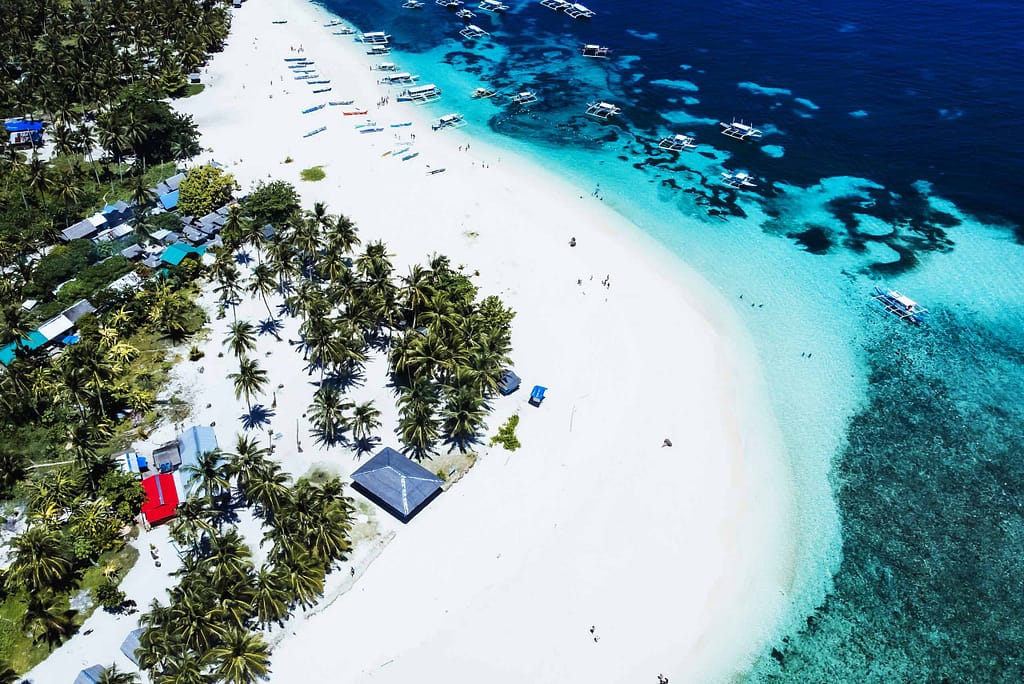
Aerial View of a Tropical Island with White Sand Beach
Best Time to Explore Cebu Island
As with any journey that crosses time zones and climate boundaries, timing plays a crucial role in unlocking the most memorable experiences. Nestled in the heart of the Philippines, the island of Cebu enjoys a warm tropical climate year-round, but the most ideal window to explore its diverse landscapes is during the dry season, which stretches from December through May. During these months, the skies are reliably clear, the sun graces the island with golden light, and the sea invites travelers with calm, crystalline waters.
This season offers an optimal backdrop for immersing yourself in Cebu’s many treasures whether you’re tracing the roots of Philippine history at Magellan’s Cross, wandering through the lively streets and colonial-era landmarks of Cebu City, or unwinding along the powdery white sands and turquoise shallows of Mactan Island. Outdoor excursions, from hiking the rolling hills of the highlands to diving among vibrant coral reefs, are at their best when the weather is steady and serene. Visiting Cebu during this time not only enhances the beauty of each scene but ensures that every adventure, cultural encounter, and seaside escape is lived to its fullest.
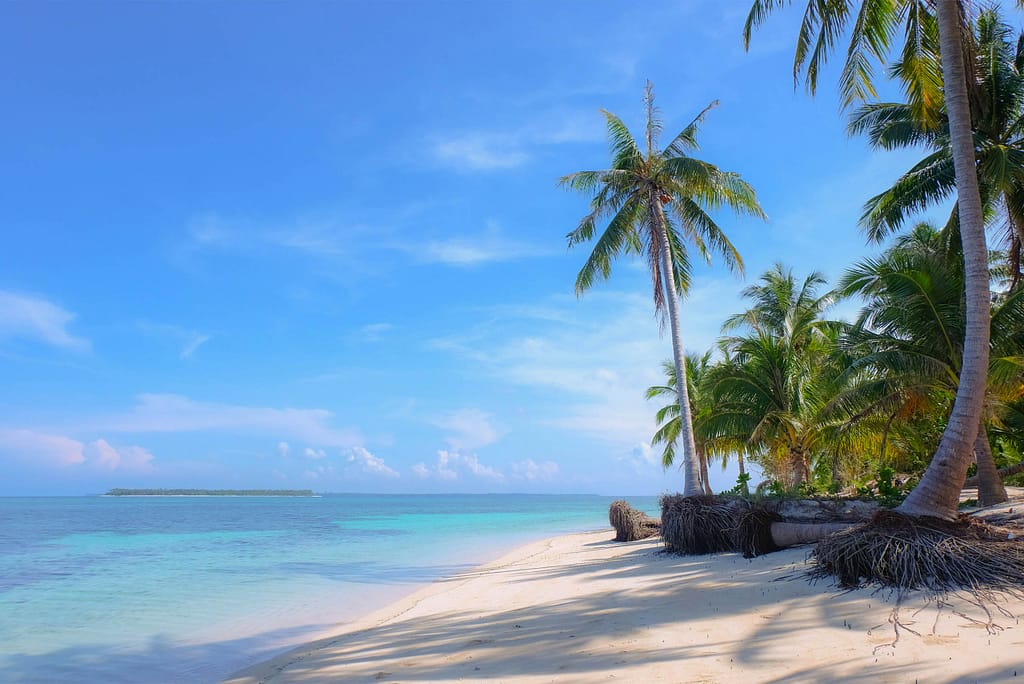
A tropical beach with palm trees and clear water
Must-Know Travel Tips for Cebu Visitors
Cebu is more than just a tropical escape—it’s a dynamic blend of centuries-old heritage and breathtaking natural beauty, offering something for every kind of traveler. From culturally immersive city tours to off-the-beaten-path adventures, these expert travel tips will help you unlock the island’s most rewarding experiences.
Venture Beyond the Tourist Trail
While iconic landmarks like Fort San Pedro, Magellan’s Cross, and the vibrant Colon Street are essential stops in Cebu City, some of the island’s most unforgettable moments are found away from the crowds. Go beyond the guidebooks and explore the rugged interior landscapes and quiet countryside.
Seek out lesser-known treasures such as Kabutongan Falls in Malabuyoc—a stunning, multi-tiered waterfall nestled in a secluded canyon, perfect for adventurous treks and cliff-jumping. Wander through the vivid colors of the Sirao Flower Garden, often called the “Little Amsterdam of Cebu,” where celosia blooms paint the hillsides in reds and yellows, especially striking at sunrise.
These spots provide a tranquil counterpoint to the city’s bustle, offering a glimpse of rural life and unspoiled nature that many travelers miss.
Embrace and Respect Cebu’s Deep-Rooted Traditions
Cebu’s cultural identity is steeped in centuries of history, religion, and community pride. To fully appreciate your journey, engage with these traditions thoughtfully and respectfully.
When visiting sacred sites such as the Basilica Minore del Santo Niño, Cebu Metropolitan Cathedral, Cebu Heritage Monument, or the grand and ornate Simala Shrine, modest attire is highly encouraged. These places aren’t just attractions—they are active centers of faith for locals.
Timing your visit during the Sinulog Festival in January allows for an immersive experience into Cebuano culture. This week-long celebration features vibrant street dances, religious processions, and cultural shows. Whether you join in the revelry or simply observe, be mindful of local customs: ask before taking photos, follow crowd etiquette, and greet people with a smile or a polite “Maayong buntag” (Good morning).
Plan Ahead for Island Hopping and Marine Adventures
The Cebu archipelago is surrounded by crystalline waters and dotted with islands that promise both serenity and adventure. Organize your itinerary to include island-hopping tours, which are among the most rewarding ways to explore the region’s coastal charm.
Set sail to Bantayan Island, known for its powdery white beaches and laid-back vibe, or Malapascua, a diving haven where you can swim with thresher sharks at Monad Shoal. Don’t miss the Camotes Islands for their natural caves and tranquil atmosphere, and Nalusuan Island Marine Sanctuary, perfect for snorkeling amidst thriving coral reefs.
For water lovers, pack reef-safe sunscreen, quick-dry clothing, and underwater cameras to make the most of stops like Moalboal’s Panagsama Beach, where sardine runs and turtle sightings are almost guaranteed, or Sumilon Island, known for its crystal-clear sandbar and protected marine life.
Booking island tours in advance—especially during peak season—can save time and ensure access to the most sought-after spots.
Getting to Cebu and Exploring Locally
Cebu is one of the Philippines’ most accessible travel hubs, thanks to the Mactan-Cebu International Airport (MCIA)—the second busiest airport in the country and a growing regional gateway. Located on Mactan Island, just a short drive from Cebu City, the airport welcomes daily domestic flights from Manila, Davao, and Clark, as well as international routes from hubs like Singapore, Seoul, Hong Kong, and Tokyo. With modern facilities and efficient immigration services, arriving in Cebu is both smooth and convenient.
From the Airport to the City
Once you land, a variety of transport options are readily available:
- Taxis and Grab (ride-hailing app): For comfort and air-conditioning, taxis or Grab are the most convenient choices, especially if you’re heading to hotels or destinations within Metro Cebu. Expect to pay a bit more than public transport, but it’s well worth it for hassle-free transfers—particularly after a long flight.
Airport Buses: The MyBus system connects the airport with several key drop-off points in Cebu City, including SM City Cebu and the South Road Properties (SRP) area. It’s an affordable and air-conditioned option, ideal for solo travelers or light packers.
Getting Around Cebu City and Metro Cebu
Cebu City is a dynamic blend of urban sprawl and colonial charm, and navigating it requires a bit of planning:
- Jeepneys: The most iconic mode of public transportation in the Philippines, jeepneys are colorful, budget-friendly, and part of the local culture. Each route is labeled with codes and signs, but they can be confusing for newcomers. Be sure to ask locals or check Google Maps for assistance. Jeepneys are best for short distances if you’re feeling adventurous.
- Buses and Modern Jeepneys: For longer commutes within the city and neighboring municipalities like Mandaue or Talisay, modernized buses and e-jeepneys offer a more comfortable alternative, often with air-conditioning and designated stops.
- Motorcycle Taxis (Habal-Habal): In more rural or mountainous areas of Cebu, habal-habal (motorcycle taxis) are popular among locals. They’re a thrilling way to experience the landscape up close, but be sure to wear a helmet and agree on the fare before the ride.
Exploring Beyond the City: Go Off-Grid
To truly experience Cebu’s natural wonders, venture outside the metro and embrace the island’s diverse terrain. Renting a motorbike or scooter is one of the best ways to explore the countryside at your own pace. Cruise along the coastal roads of South Cebu, making spontaneous stops at attractions like Kawasan Falls, Tumalog Falls, or the quiet town of Alegria. Or take a ferry or bus to North Cebu to reach the white-sand shores of Bantayan Island, where you can unwind in peace.
For longer journeys between cities or to major jump-off points for island hopping (like Moalboal, Oslob, or Danao), consider riding long-distance buses departing from the South Bus Terminal or North Bus Terminal. These buses are budget-friendly and reliable, with routes that traverse most of the island.
Pro Tips for a Smooth Ride in Cebu
- Download Offline Maps: Apps like Google Maps, Maps.me, or Grab are lifesavers when signal gets spotty.
- Carry Small Bills and Coins: Public transport fares are usually paid in cash, and exact change helps speed things up.
- Plan Around Traffic: Cebu City can get congested during rush hours (7–9 AM and 5–8 PM), so plan travel time accordingly.
Best Things to Do in Shibuya
Visiting Cebu is a truly rewarding experience, offering an extraordinary blend of cultural heritage, natural wonders, and island charm—each destination promising unforgettable moments and one-of-a-kind adventures. From the centuries-old churches and vibrant festivals of Cebu City to the pristine beaches of Bantayan and the crystal-clear diving spots of Moalboal, Cebu caters to every kind of traveler. Whether you’re chasing waterfalls in the south, exploring hidden coves on remote islands, or savoring authentic Cebuano cuisine in bustling night markets, each corner of this island reveals a new story—making every journey not just memorable, but meaningful.
Exploring the Stunning Beauty of Kawasan Falls
Tucked away in the lush rainforests of Badian, Southern Cebu, Kawasan Falls is one of the Philippines’ most iconic natural wonders—a multi-tiered waterfall renowned for its dazzling turquoise waters, dramatic limestone cliffs, and jungle-fringed pools. This tropical oasis isn’t just a place to admire nature—it’s a full-blown adventure.
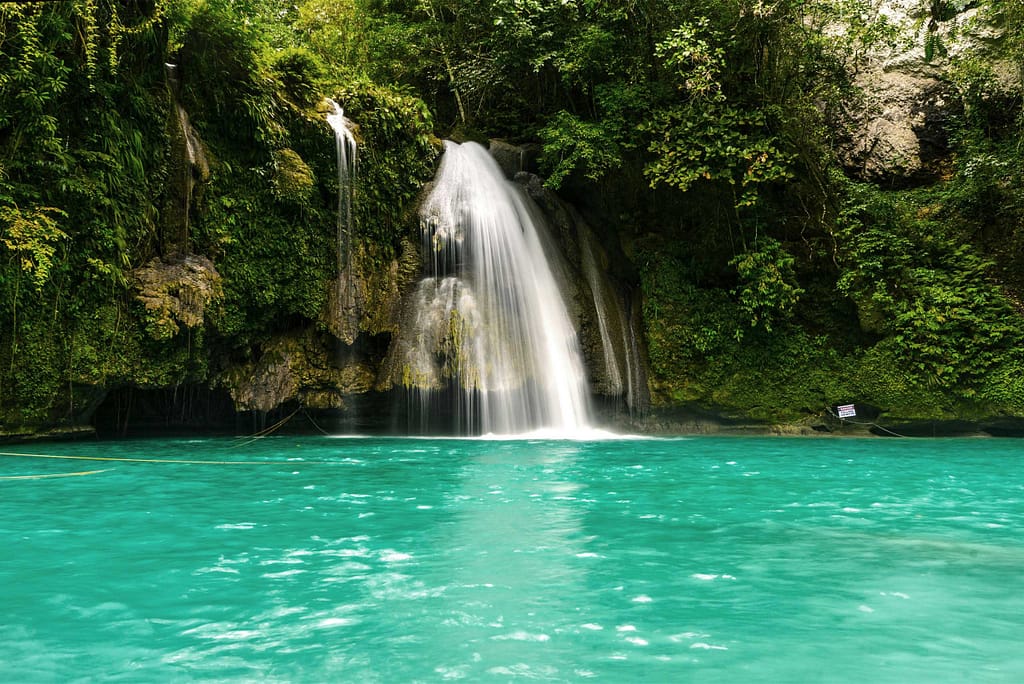
Waterfalls in the Middle of the Forest
The journey to Kawasan is just as exhilarating as the destination. Visitors often opt for a guided canyoneering experience starting from the town of Alegria. This adrenaline-pumping route takes you trekking through river trails, rappelling down rocks, cliff-jumping into emerald pools, and floating along cool freshwater streams, all while surrounded by the untouched beauty of Cebu’s highlands.
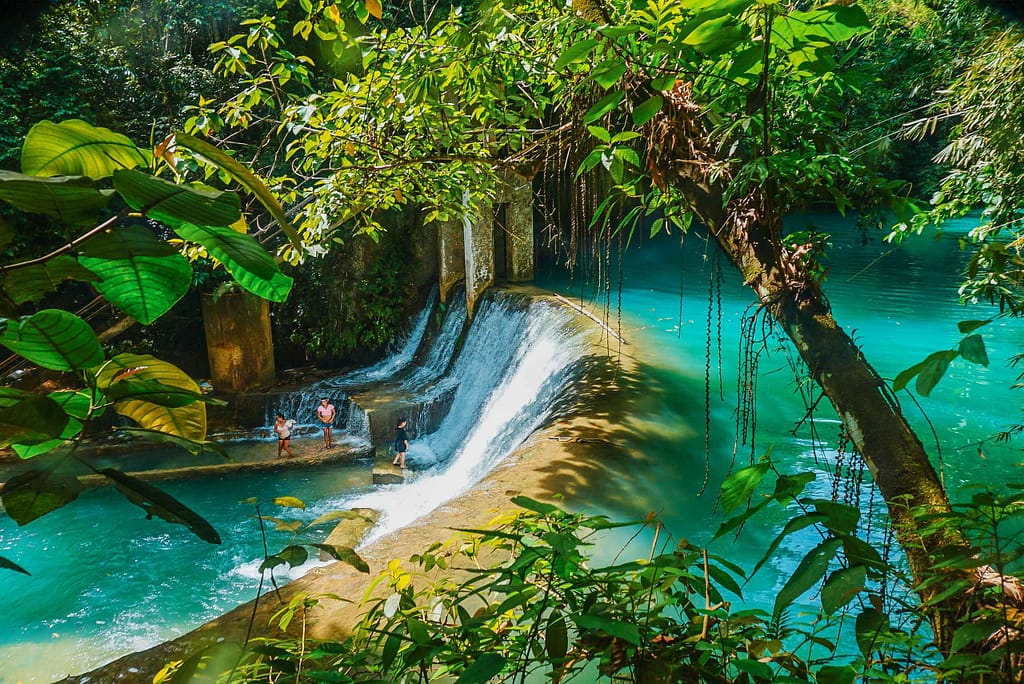
Enchanting Kawasan Falls, Badian, Cebu Island.
At the base of the falls, you’ll be greeted by the main cascade, a 40-meter drop of crystal-clear water plunging into a large, swimmable basin. Wooden rafts are available for rent, allowing you to glide under the falls for a natural back massage or simply to take in the view from the water’s surface. Surrounding picnic areas and bamboo cottages offer places to relax, making it perfect for both thrill-seekers and laid-back nature lovers.
Whether you’re leaping into deep canyons or just soaking up the serene jungle vibe, Kawasan Falls delivers a rare mix of adventure, tranquility, and tropical beauty—making it a must-visit gem in any Cebu itinerary.
Exploring the Historic Legacy of Magellan’s Cross
Nestled in the vibrant heart of Cebu City, just beside the revered Basilica Minore del Santo Niño, stands the legendary Magellan’s Cross—a revered emblem of the Philippines’ colonial past and religious heritage. Planted in 1521 by Portuguese explorer Ferdinand Magellan under the flag of Spain, this historic cross marks the introduction of Christianity to the archipelago.
Encased in a protective chapel to preserve its original form, Magellan’s Cross is more than just a wooden relic—it symbolizes a pivotal turning point in Philippine history, where native culture and European influence first collided and merged. The painted ceiling above the cross vividly depicts the first baptism of Cebu’s chieftain Rajah Humabon, his wife, and hundreds of their followers—an event that would set the stage for centuries of Spanish colonization.
Today, this iconic site draws pilgrims, cultural enthusiasts, and curious travelers alike, serving not only as a place of reflection but also as a cornerstone of Cebu’s identity. Whether you’re tracing the roots of Christianity in the Philippines or simply uncovering the rich layers of Cebu’s past, Magellan’s Cross offers a compelling glimpse into the enduring legacy of faith, colonization, and Filipino resilience.

Magellan’s Cross © Wikipedia
Experience World-Class Diving in Moalboal Waters
Moalboal, nestled on Cebu’s picturesque southwest coast, is an unrivaled haven for those seeking unforgettable underwater experiences. This tropical paradise boasts a thriving marine ecosystem, with crystal-clear waters that are home to vibrant coral gardens and an astonishing variety of sea life. One of the area’s most iconic natural wonders is the awe-inspiring sardine run at Panagsama Beach, where millions of sardines move in mesmerizing, synchronized patterns, creating a breathtaking spectacle for snorkelers and divers alike.
Beyond the sardine run, Moalboal’s dive sites are celebrated for their diverse underwater landscapes, from dramatic drop-offs to colorful reef systems teeming with tropical fish, turtles, and unique marine species. The crystal-clear visibility allows for uninterrupted exploration of these underwater treasures, making Moalboal a must-visit destination for marine enthusiasts and adventure seekers.
Whether you’re an experienced diver or a first-time snorkeler, Moalboal offers an immersive journey into the heart of Cebu’s thriving marine life, providing unforgettable moments beneath the waves.
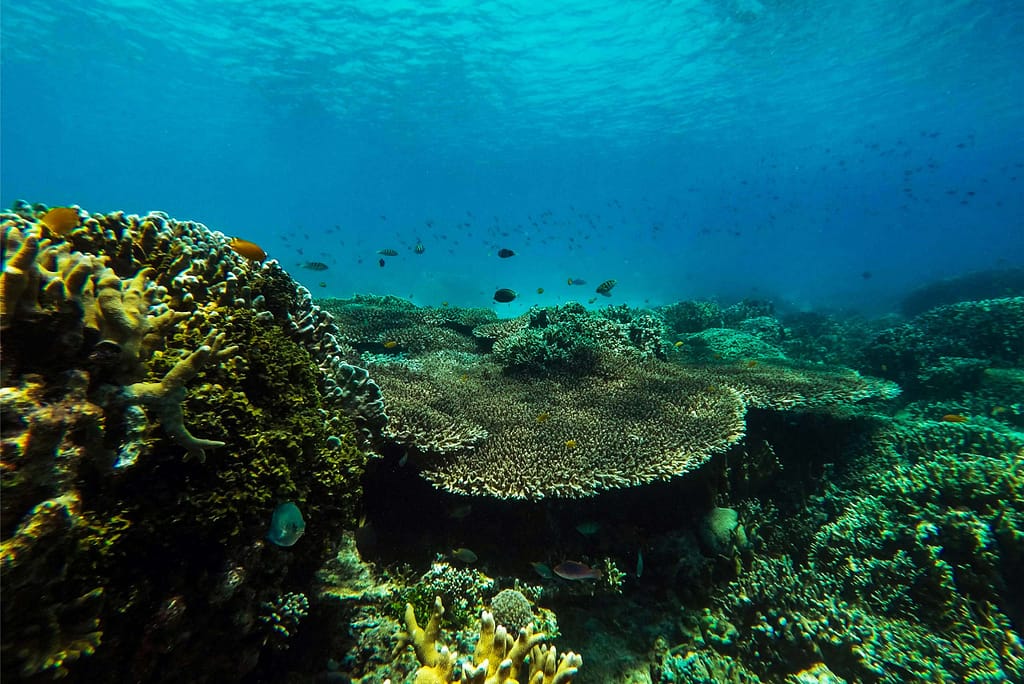
Brown coral reef under water
A Majestic Experience with Oslob Whale Sharks
Oslob, nestled on the southern coast of Cebu, presents an extraordinary chance to witness one of nature’s most awe-inspiring spectacles—the opportunity to swim with the world’s largest fish, the majestic whale sharks. These gentle giants glide effortlessly through the crystal-clear waters, offering visitors a rare, intimate experience with marine life in its purest form.
The encounter with these magnificent creatures is nothing short of humbling. As you float beside them, their sheer size and grace leave a lasting impression, while the serene environment amplifies the profound connection with the ocean’s wonders. This unique experience is more than just a chance to marvel at these incredible animals; it’s an invitation to immerse yourself in the delicate balance of marine ecosystems that thrive off the coast of Cebu.
Whether you’re snorkeling or diving, the crystal-clear waters of Oslob provide an unobstructed view of the whale sharks as they feed, swim, and glide through the vibrant coral gardens. This once-in-a-lifetime adventure not only opens a window into the lives of these majestic creatures but also fosters a deeper appreciation for the preservation of marine biodiversity. The Oslob whale shark encounter is a truly unforgettable journey, creating memories that last a lifetime while highlighting the extraordinary marine wonders of Cebu.
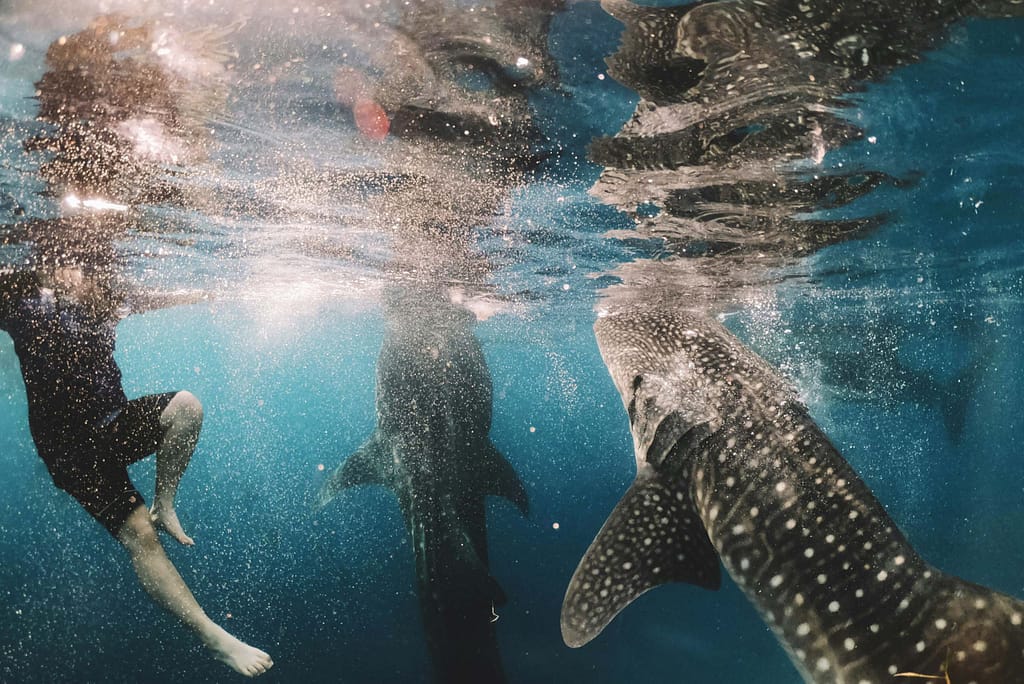
Whale shark swimming near person under water
Embark on a Malapascua Island-Hopping Journey
Malapascua Island is an idyllic tropical retreat, offering everything you could wish for in a perfect getaway. With its pristine white sand beaches and crystal-clear waters, the island is a haven for both relaxation and adventure. Its underwater world is equally mesmerizing, particularly for diving enthusiasts. The island is renowned for its world-class diving spots, where one of the most thrilling experiences is the chance to encounter the elusive thresher shark. This remarkable sighting, along with vibrant coral reefs and abundant marine life, makes Malapascua a must-visit destination for those seeking both tranquility and aquatic exploration.
Hike to Breathtaking Osmeña Peak Views
Cebu isn’t just a paradise for divers and beachgoers—it’s also a dream destination for hikers and nature lovers. One of the most rewarding adventures awaits at Osmeña Peak, the highest point on the island, located in the cool, rugged highlands of Dalaguete. Rising approximately 1,013 meters above sea level, this jagged limestone summit offers a stunning panorama that stretches from the island’s mountain ridges to the distant coastline and neighboring islands on clear days.
The trail to Osmeña Peak is short and relatively easy, making it accessible even for beginners. A leisurely 20- to 30-minute hike through vegetable farms and rolling hills leads you to the summit, where you’re met with breathtaking 360-degree views. The landscape is often likened to the Chocolate Hills of Bohol—only sharper and more dramatic, with pointed peaks that make the scenery truly unique.
This iconic hiking spot is especially popular at sunrise and sunset, when the sky paints the surrounding mountains in soft, golden hues. Whether you’re an avid trekker or a casual adventurer, hiking Osmeña Peak offers a serene escape and a spectacular way to experience Cebu’s natural beauty from above.
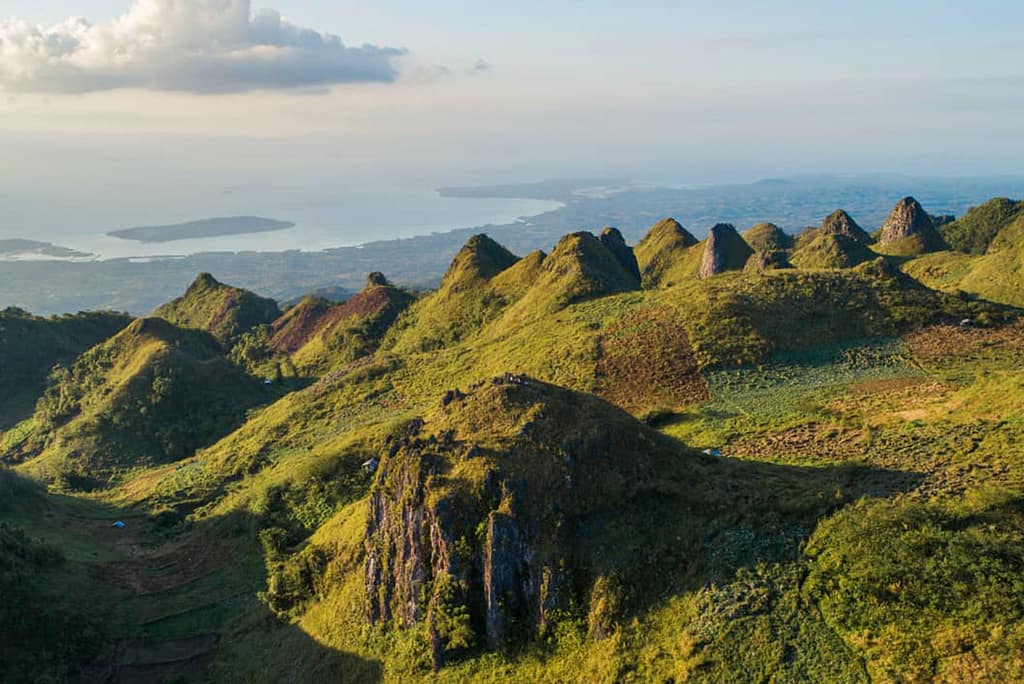
OSMENA PEAK HIKE CEBU
Discover Tranquility on Bantayan’s Beautiful Beaches
Bantayan Island, tucked away off the northern coast of Cebu, is a sun-drenched sanctuary that perfectly blends natural beauty, local culture, and laid-back island life. Renowned for its powdery white-sand beaches and crystal-clear turquoise waters, Bantayan is a dream destination for those seeking serenity, scenic charm, and an authentic coastal escape.
Begin your beachside retreat at Paradise Beach, a secluded haven embraced by lush vegetation and calm, shallow waters—ideal for quiet swims, reading under swaying palms, or simply basking in the stillness of nature. For a livelier vibe, head over to Kota Beach, famous for its expansive sandbar that stretches gracefully into the sea, creating a picture-perfect scene that’s a favorite among photographers and sunset chasers alike.
But Bantayan is more than just beautiful beaches. Take a step back in time with a visit to the Sts. Peter and Paul Parish Church, one of the oldest churches in the Visayas, built in the 1500s from coral stones. Connect with the vibrant local culture through bustling town markets and seafood feasts, or head into nature for a peaceful walk through the Obo-ob Mangrove Eco Park, where elevated bamboo walkways lead you through a thriving coastal ecosystem teeming with life.
Whether you’re lounging by the shore, kayaking through mangroves, or exploring heritage sites, Bantayan Island offers a well-rounded experience—perfect for travelers looking to unwind while discovering the soul of Cebu’s northern gem.
Bouldering Adventure Awaits at Miyashita Park
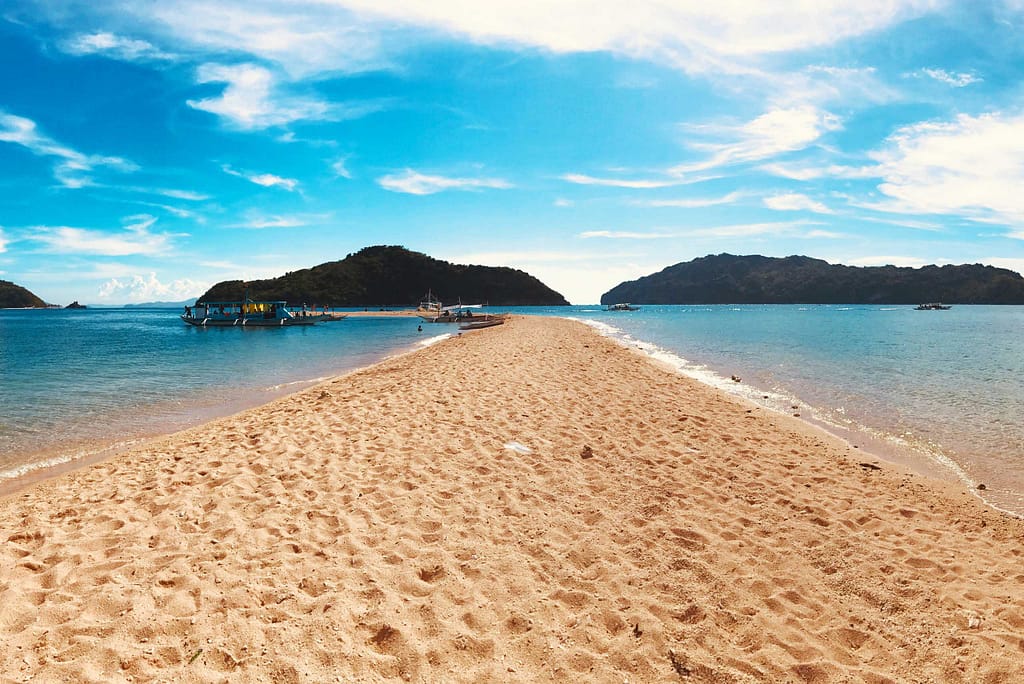
Tranquil Beach with Clear Waters in Bantayan
Delight in Traditional Cebuano Food and Seafood
Cebu’s culinary scene is a rich tapestry woven from centuries of cultural influences—blending indigenous traditions with Chinese, Spanish, and American flavors to create a food culture that is both diverse and deeply rooted in local identity. Every dish tells a story of heritage, community, and the island’s deep connection to land and sea.
A must for any foodie visiting Cebu is the legendary lechon, a whole roasted pig with perfectly crispy skin and tender, flavorful meat. Celebrated by locals and tourists alike, Cebu’s lechon is often hailed as the best in the Philippines, praised for its unique blend of spices and charcoal roasting method that locks in flavor without the need for sauce.
But Cebu’s culinary treasures go far beyond lechon. Kinilaw, a local take on ceviche, features raw fish marinated in vinegar, calamansi juice, ginger, and chilies—delivering a fresh, tangy bite that perfectly reflects the coastal lifestyle. Meanwhile, humba is a beloved Visayan dish—a sweet-savory braised pork belly stew simmered in soy sauce, brown sugar, and fermented black beans, often compared to adobo but with a richer depth of flavor.
Seafood also plays a starring role in Cebuano cuisine. Along the island’s coastlines and in bustling food markets, you’ll find everything from grilled squid and shrimp to scallops, sea urchins, and tangigue (Spanish mackerel), all served freshly caught and expertly prepared.
Whether you’re dining at a seaside eatery, exploring a local market, or sampling festival fare during the Sinulog Festival, Cebu’s cuisine offers a feast for the senses—where every bite carries the warmth, history, and hospitality of the island.
Explore Cebu’s Untouched Falls and Landscapes
Lorem ipsum dolor sit amet, consectetur adipiscing elit. Ut elit tellus, luctus nec ullamcorper mattis, pulvinar dapibus leo.
Beyond Cebu’s bustling cities and world-famous beaches lies a lesser-known yet equally captivating side of the island—its verdant countryside, home to some of the Philippines’ most enchanting natural wonders. Here, winding roads lead to hidden waterfalls, lush mountain trails, and rural communities that offer a refreshing contrast to the urban and coastal scenes.
One of the best ways to experience this tranquil side of Cebu is by chasing waterfalls—literally. While Kawasan Falls may steal the spotlight, there are many equally breathtaking, off-the-beaten-path cascades worth exploring. Inambakan Falls in Ginatilan showcases a dramatic 100-foot drop into a turquoise basin surrounded by dense jungle, perfect for a peaceful swim or nature retreat. Over in Oslob, Tumalog Falls offers an ethereal spectacle, with fine, curtain-like streams cascading down mossy cliffs into shallow, misty pools—a favorite among photographers and nature lovers.
For thrill-seekers, Aguinid Falls in Samboan is a natural playground. This multi-tiered limestone waterfall challenges visitors to climb its various levels with the help of ropes and guides, making it an exhilarating mix of hiking and canyoning set in a jungle paradise.
These countryside gems not only showcase the island’s natural beauty but also offer a deeper connection to Cebu’s quiet rural life—where locals live close to nature, far from the noise of the city. Whether you’re cooling off in a hidden pool, hiking through mountain trails, or simply breathing in the fresh provincial air, exploring Cebu’s waterfalls and countryside is an experience that redefines adventure and serenity.
- Unveiling the Wonders and Thrills of Cebu on a Journey Through the Heart of the Philippines.
- Crafting the Ultimate Cebu Travel Experience
- Best Time to Explore Cebu Island
- Must-Know Travel Tips for Cebu Visitors
- Getting to Cebu and Exploring Locally
- Best Things to Do in Shibuya
- Exploring the Stunning Beauty of Kawasan Falls
- Exploring the Historic Legacy of Magellan’s Cross
- Experience World-Class Diving in Moalboal Waters
- A Majestic Experience with Oslob Whale Sharks
- Embark on a Malapascua Island-Hopping Journey
- Hike to Breathtaking Osmeña Peak Views
- Discover Tranquility on Bantayan’s Beautiful Beaches
- Bouldering Adventure Awaits at Miyashita Park
- Delight in Traditional Cebuano Food and Seafood
- Explore Cebu’s Untouched Falls and Landscapes





